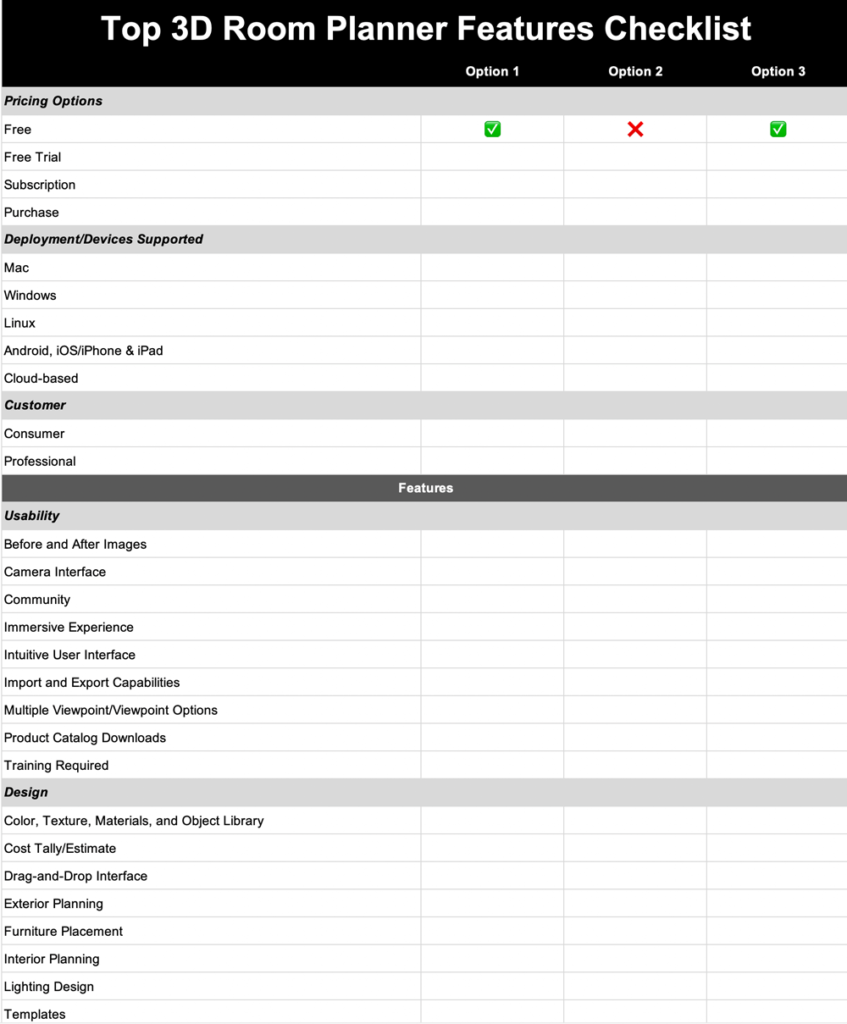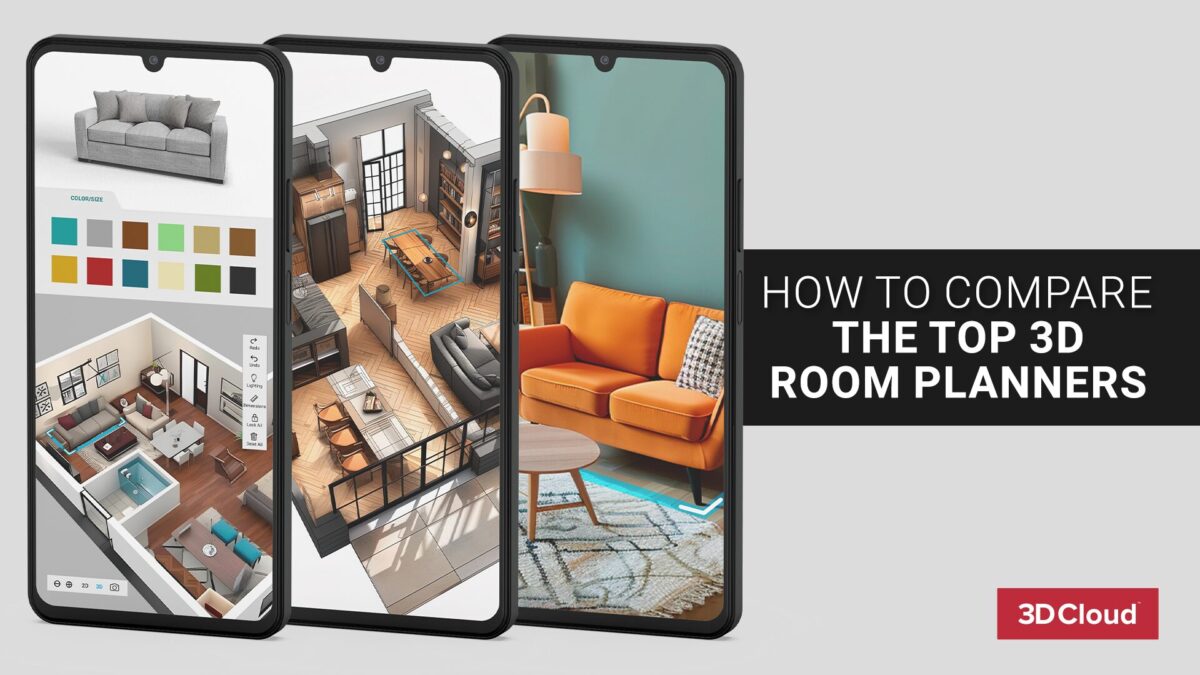
Ultimate Guide to Comparing Top 3D Room Planners
Professional and amateur designers save time and money by pre-planning a space. Interior Designer Natalia Zieba shares insights and tips for comparing 3D room planners. Plus, you’ll find useful checklists, videos, and the difference between free and paid 3D room planners. To learn more about the content required to launch a 3D Room Planner, you’ll want to check out this companion article Room Planner 101: How much content does a 3D Room Planner need.
Included in this article:
What Is a 3D Room Planner?
“A 3D room planner is a virtual modeling and visualization tool to help designers, architects, retailers, or consumers pre-create spaces: interiors, interior designs, or architectural plans to scale,” says Natalia Zieba, Interior Design and Training Lead for 3D Cloud, a 3D design and visualization innovation company.

Natalia Zieba, Interior Design and Training Lead for 3D Cloud
“The goal is to transfer ideas from your brain and place them in a Virtual Reality environment. Once the plan is satisfactory from a practical and aesthetic perspective, then you can make the space in reality,” says Zieba.
3D planners are a step up from 2D planners. Zieba explains that “2D planners or 2D floor house plans provide a bird’s eye view that tells the consumer or designer to work on x or horizontal axis and y or vertical axis. 2D planners provide a visual display of the room layout, walls, and fixed features like doors, stairs, and windows to make it easier to determine furniture or cabinet placement.” Designers often use these as the initial sketches before starting architectural and interior design plans.
A 3D floor plan provides a scaled view with an in-depth look into a proposed space design. “3D floor plans exhibit three axes: x, y, and z, which represents depth—meaning walls, floors, and ceiling,” Zieba clarifies. “3D floor plans are rich with animated options for an enhanced user experience. In 3D plans, the user takes control and can rotate the view and look at a structure from various perspectives.”
Demo of a 3D Planner
The best 3D planners offer a fast and intuitive way to focus on defining a space or making modifications.
Who Uses 3D Dimension Planners?
Interior designers, architects, real estate agents, construction engineers, government planners, and event planners use 3D planners. An increasing number of kitchen and bath design, furniture, and paint retailers use dimensional planners to help customers visualize rooms and drive sales.
When it comes to expensive design from scratch projects, Zieba advises, “Hire an architect or designer who uses professional software. Most consumer 3D planner apps are simplified and easy to learn. Professionals need to get into finer details to show space planning, fabric selections, and other recommendations that make an aesthetic and price difference to clients.”
How Can I Make a 3D Room Plan?
Increasingly, people embarking on home makeovers turn to 3D planners. “There are excellent solutions available to create a 3D room plan for the non-professional,” Zieba shares. “Today, lots of consumers use room planners for inspiration and to begin creating their dream spaces.”
The best 3D planners provide a way to incorporate overarching design elements, such as structural details, decorative items, and the ability to size or resize rooms.
Essential Attributes in Room Layout Plans
There are three overarching considerations before you start space planning:
- Structural Elements: 3D planners provide a way to see fixed elements like walls, windows, doors, stairs, fireplaces, and ceilings in a plan. Advanced apps for engineers and architects also provide the ability to plan hidden systems like foundations, heating, and plumbing. These apps also include a simplified way to track revised sets of drawings, called as-built measurements, which document alterations made during construction.
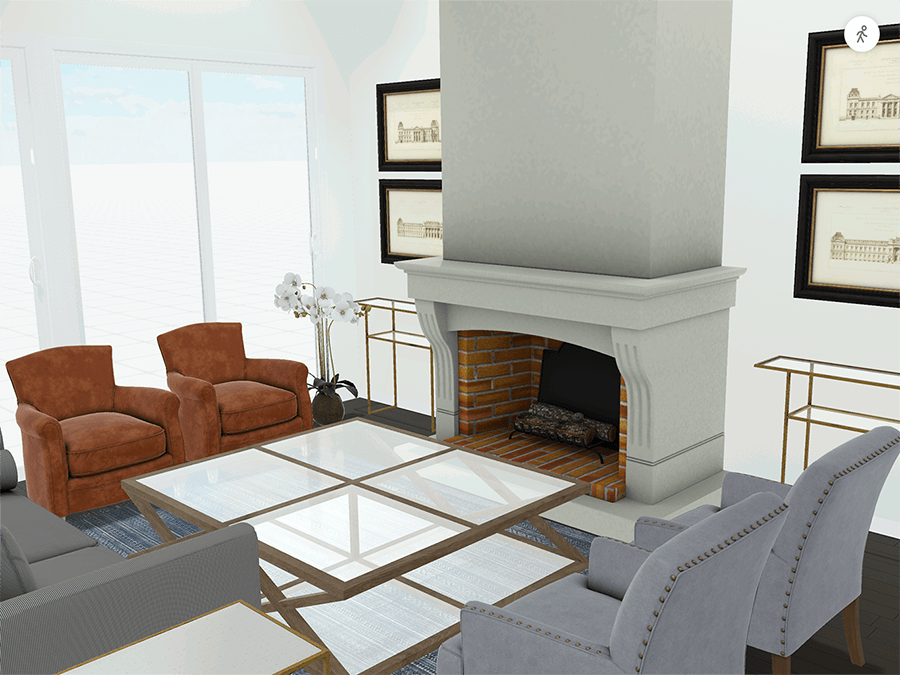
Seeing how natural lighting affects a space can influence paint colors, textures, wall placement, window treatments, and furniture selection.
- Style: Your style should inform all design choices from paint to porches. If you’re not sure what style suits you best—contemporary, country cottage, or some other interior design style—the best 3D planners let you experiment with a variety of looks so you can pick one that suits you.
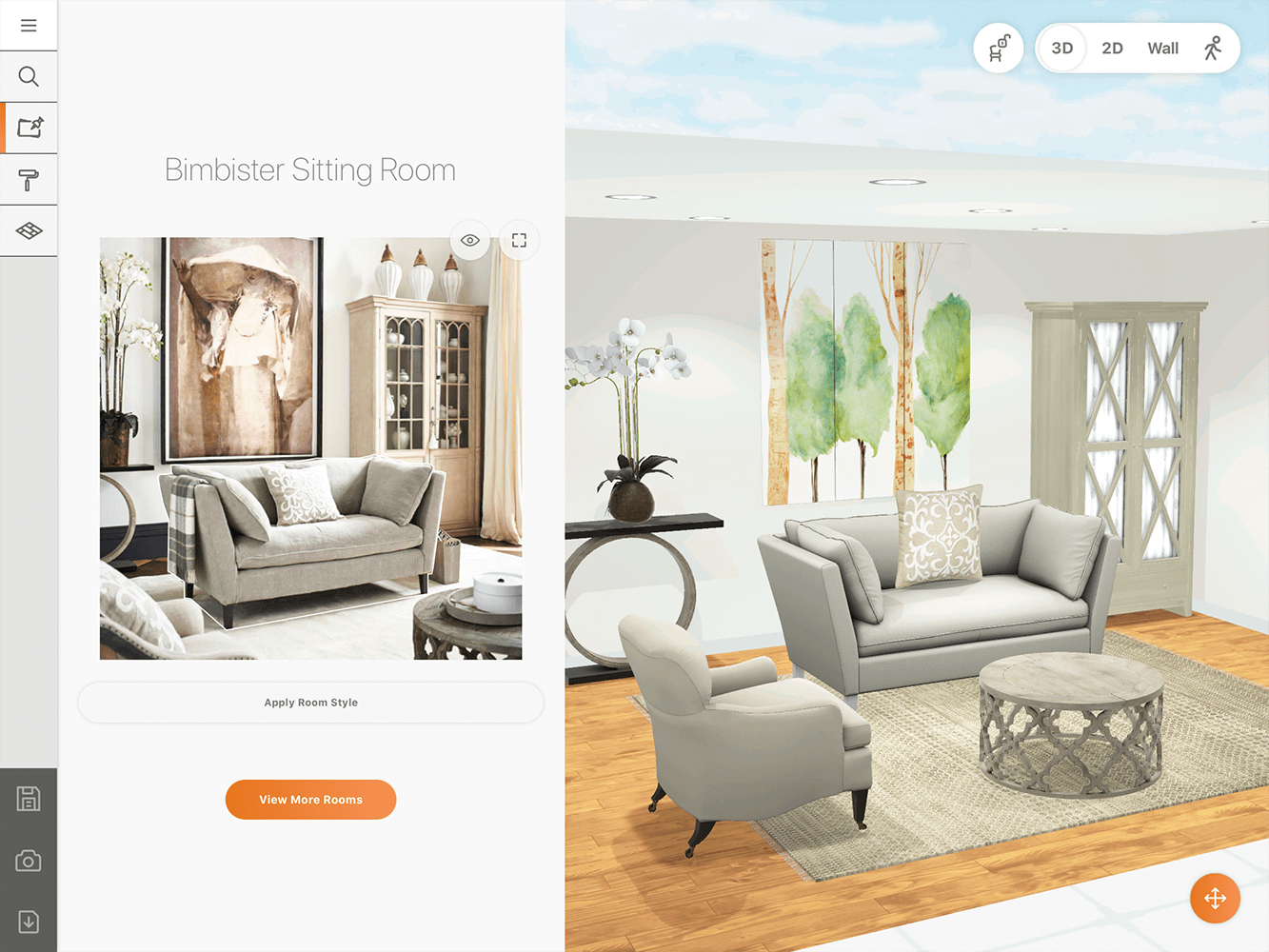
Style choices determine the final impression of any interior space.
- Accurate Dimensions: You can measure using a traditional tape measure and then type dimensions into the program. Or, use a laser distance measuring Bluetooth tool, iPhone, or iPad measurement app that inputs data directly input into the design program. The results are often more accurate. With iPad, iPhone, or Android phone measurement apps, you snap photos that automatically capture room dimensions. The app uses that data to make floor space calculations. At that point, you can drag walls into place, add other structural elements, and complete the room plan.
Space Specific Tools in a Top Furniture Planner
Room planners provide a way to conceive unique spaces and their components:
- Kitchens: New or remodeled kitchens can be the most expensive home investment because of the cost of cabinetry and appliances. Select a software planner geared to kitchen designs since component spacing is critical. Learn more at Kitchen Floor Plans 101 or view a sample of a high-end, easy-to-use 3D Kitchen Design Tool.
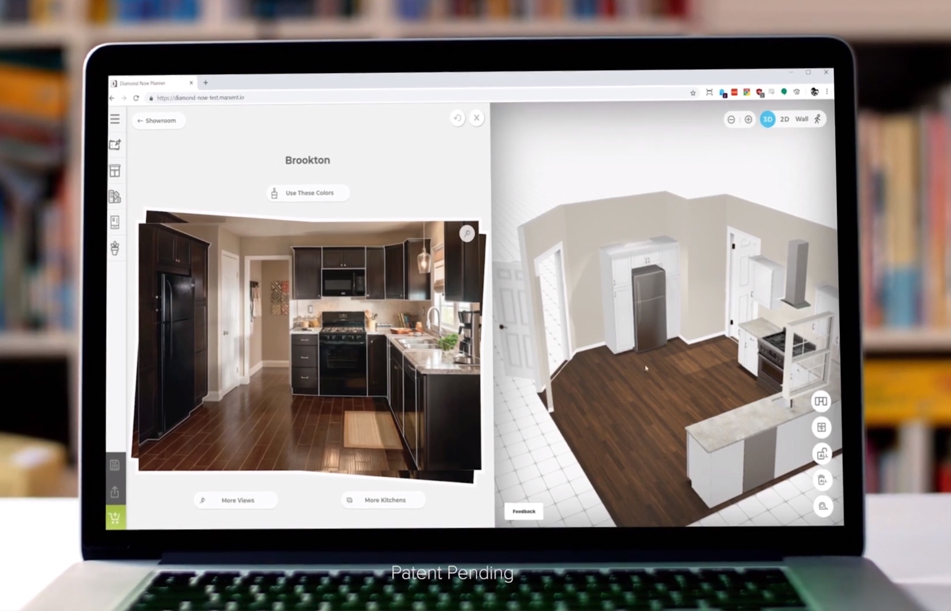
Understanding how various elements work in a kitchen and the ability to move or change them can save thousands of dollars and headaches.
- Kitchen Cabinetry: Some of the most expensive items in a kitchen remodel is the cabinetry, whether purchased or custom designed. Ensuring a perfect fit physically and visually prevents long-term regrets.
- Bathrooms: The second most expensive room to build or remodel are bath and powder rooms. The space is often small but brimming with functional requirements. A room planner can create a floor plan, try multiple layouts, and see how materials, fixtures, and storage solutions work together to create a cohesive space.
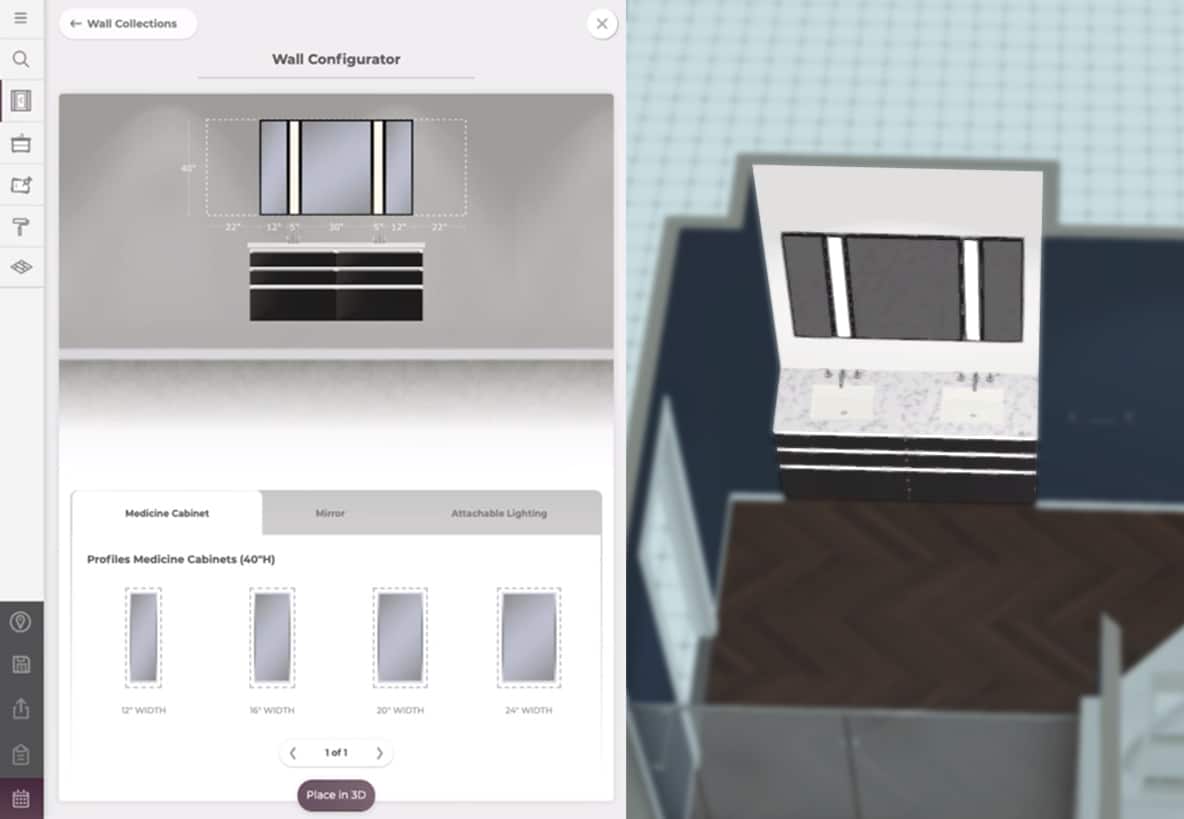
Bathrooms can be tricky to design because these are often tight spaces that must offer maximum utility and adequate storage.
- Bathroom Cabinetry: Bathrooms are usually small spaces, so taking steps to ensure the correct scale is key to a successful design.
- Kitchen and Bath Fixtures: Make sure that hardware and appliances fit your budget and style.
- Plumbing Fixtures: Plan the purchase of sinks, tubs, showers, toilets, and bidets with care to ensure longevity since replacement costs are high.
- Hardware: The jewelry of kitchen and bath design, visible plumbing fixtures like showerheads, faucets, and handles can elevate the look and functionality of bathrooms and kitchens. Door handles should be both attractive and functional since cabinet doors and drawers are opened thousands of times a year.
- Kitchen Appliances: Appliances are costly, so it’s essential to ensure they will fit size-wise and style-wise as well as meeting your food storage, preparation, and cleaning requirements.
- Dining Room: Developing the feel, look, and flow of a formal or informal dining room begins with the placement in the home. Locate the room near the kitchen, particularly in an open-plan scheme.
- Living room: Gathering spots for family and friends need to provide comfort and a place to socialize. Try out different furniture groupings, style, and color elements to create a welcoming environment that has a good flow.
- Bedroom: A haven for rest and restoration, you should plan bedrooms accordingly, with a bathroom en-suite or nearby. Remember, children and teens may need a desk or play space.
- Office: Workspace plans require many of the same elements as living spaces but must also take ergonomics, or the efficiency of the working environment into account to increase efficiency, productivity, and reduce discomfort.
- Media Room: Viewing distance, light and sound design, technology, and comfort must meld together in media rooms. These rooms can be complex, so it’s wise to consult with an expert.
- Patio, Deck, and Garden: More than ever, exterior spaces are an extension of the home and should reflect the way you decorate, relax, and entertain.
- Furniture Arrangements and Purchase: The best 3D planners will help you understand how upholstered furniture, tables, chairs, and shelving units will fit in a room, affect sightlines, and blend with décor so you can prevent furniture returns and inconvenience.
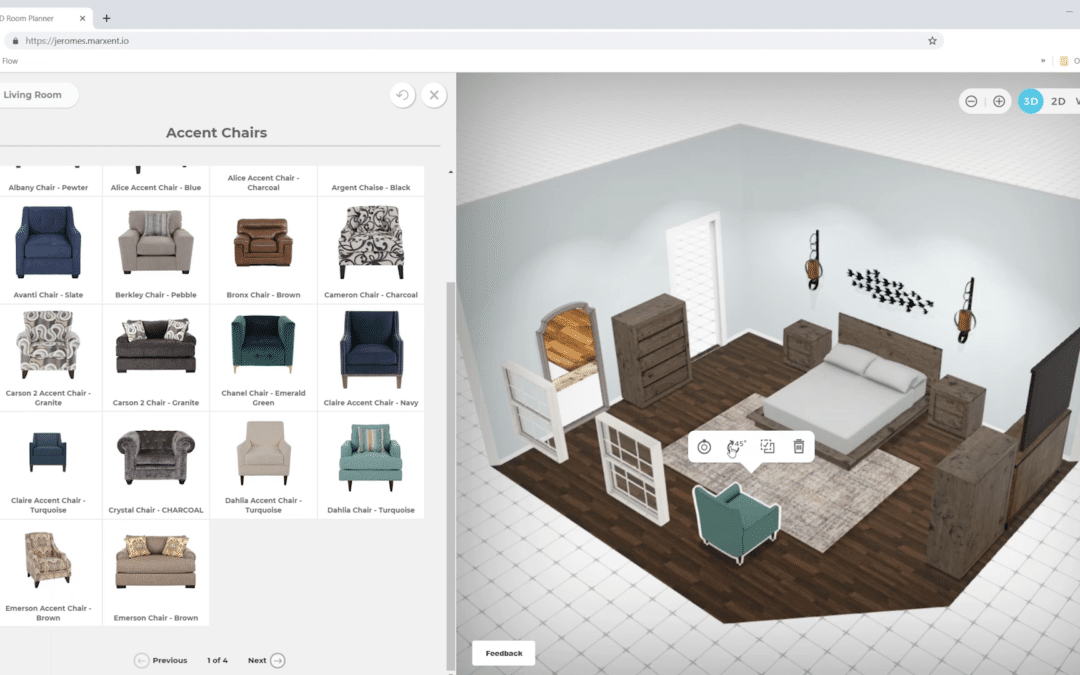
Flexibility in design comes from having the ability to use technology to move and change the color of furniture easily.
- Lighting: Lighting alters the ambiance of a room, its perceived size, and function. Placements and lighting types need to work with color selections, room size, natural light, and furniture. Lighting can illuminate the entire room or highlight specific elements.A 3D planner reveals how natural and artificial light will function and is useful in the design and purchase of windows or glass doors in a new or remodeled room.
- Accessories and Other Design Elements: Room planners offer a wide variety—hundreds or even thousands—of design elements. These elements include rugs, mattresses, decorative objects, paint, wall tiles, interior finishes, and big-screen TVs or projectors. The best planners offer hundreds or thousands of choices to drag-and-drop into your design.
Why You Need Online Room Planners
“The value of room planners can’t be overstated,” says Zieba. “When you visualize room design, you or your designer make better decisions, have confidence in your choices, make changes virtually, and avoid spending money to correct problems. Plus, it’s enjoyable!”
3D Planners Save Time and Money
“The ability to previsualize a room or exterior environment with 3D room planners helps professionals and consumers alike to feel the space and simulate reality, and the items in it,” explains Zieba. “People want to see their creation, especially before investing their hard-earned dollars.”
It’s also beneficial to use a room planner to provide even a simple sketch for your architect, builder, or interior decorator to ensure clear communication. “You can also look at ways to maximize your budget based on your initial ideas since you have a visual baseline to work from,” Zieba stresses. “Virtual planners provide a clear, money, and time-saving roadmap before you invest.”
What to Look for in the Best 3D Room Planners
Next-generation 3D planners that use Augmented Reality (AR) and Virtual Reality (VR) apps provide even more immersion into your design and let you experience a simulated walk through your home, office, or garden.
“The best 3D planners are easy to figure out so you can immediately get creative,” Zieba points out. “A top-of-the-line planner has lots of content and speed—in other words, it affords both the ability to play and make it real.”
Advanced Room Planner Immersion Levels
| The Difference Between 3D, AR, and VR Room Planners | |
| 3D | This option presents a simulated world where 3D models or objects move, rotate, or provide interaction. |
| AR | Using a camera, AR adds digital elements to a live view. VR may be more immersive, but AR tends to provide more user freedom. AR technology renders 3D graphics as they would appear from the camera viewpoint, superimposing computer-generated images over a user’s real-world view. |
| VR | VR provides an immersive experience that places the user inside an experience. The only limits to near-real VR experiences are content availability and computing power. |
Learn how AR and VR work in this brief video.
Retail Virtual Room Planners and Catalogs
Retailers are increasingly using AR and VR apps to provide customers with a way to visualize their home or office environments designed with their products in real-time. Using real products to furnish or decorate a virtual room also allows consumers to track potential expenditures or adjust based on their budgets.
Retailers see products move faster when they give customers an in-store Virtual Reality experience.
Online vs. Offline
The best room planner software allows you to work online with software accessed over the internet from anywhere and will even work on a mobile device. Conversely, users will need to download offline software, which you can access only from a specific computer.
Apps vs. Software
Using room planning apps in the cloud makes sense for most users. These web-based options can be free or have a subscription payment plan. Some architects or structural engineers, however, may need to buy more advanced software that they install on their machines and integrate with other in-house systems. These types of solutions offer more power and data security.
Mac 3D Room Planner Software vs. PC Room Planner Software
For years, Macs dominated the design world, while PCs running Windows ruled the business world. Now, much of our computing is cloud-or-browser-based and software once developed for one platform is developed for both, so what you use is a matter of personal preference.
Mobile vs. Desktop
Today, work happens everywhere. Mobile planners for phones or tablets provide the most convenient way to use 3D room planners. However, professional interior designers, real estate agents, builders, and architects may want to use larger screens to render greater detail or to work on multiple projects simultaneously. Architects or structural engineers s who deal with complex workflows like 3D graphics, software development, or video editing may need more computing power than what’s currently available on mobile devices.
Free vs. Paid
There are scores of free 3D planners online to visualize, create, and render your detailed plans that are usually more than robust enough for the amateur or many professional designers. Complex, paid space planning software makes sense for architects, interior designers, or developers who work with stringent requirements such as building codes, HVAC, or engineering standards.
There are many 3D room planner variations. Use this checklist to help evaluate the myriad of options.
| Top 3D Room Planner Features Checklist | |
| Pricing Options | |
| Free | Many design applications are entirely free. These versions are either something you download or use the app online within a browser. |
| Free Trial | You can try-before-you-buy a scaled-down version of the software for a limited time. |
| Subscription | Online or cloud-based apps, particularly professional programs, provide the ability to pay-by-use on a monthly or yearly basis. Fees depend on the number of users. |
| Purchase | Costs can range from just $15 to over $1000 a year for professional software/apps. |
| Deployment/Devices Supported | |
| Mac | Software designed to work with Apple computers. |
| Windows | Software is compatible with Windows PCs. |
| Linux | Native support for Linux’s open-source platform is uncommon. |
| Android, iOS/iPhone & iPad | The best room planner apps offer both Android and iOS versions. |
| Cloud-based | This option stores designs in the cloud that you can access anytime and anywhere. |
| Customer | |
| Consumer | These products tend to be easy to use and offer fewer features than professional versions. |
| Professional | Usually faster, more robust, and may require more training time. |
| Features | |
| Usability | |
| Before and After Images | Create images to save as a .jpg or .png and to print. |
| Camera Interface | Use digital photos to convert real space into an interactive, virtual floor plan. |
| Community | Browse designs submitted by fellow users for inspiration and share your own. |
| Immersive Experience | Space experience feels real and progressively improves when using 3D, AR, or VR. |
| Intuitive User Interface | Design a seamless experience that’s easy for someone to understand how to use immediately. |
| Import and Export Abilities | Scan digital photos, blueprints, or import name brand products; export created designs or products as PDFs and vector images; create snapshots online and offline. |
| Multiple Viewpoint/Viewpoint Options | Design in 3D; simultaneously view in 3D from an aerial viewpoint or navigate from a virtual point of view. |
| Product Catalog Downloads | Some apps and software include actual products (or the ability to import them) and costs to assist in visualization, planning, and budgeting. |
| Training Required | More advanced professional software like those for architects may require some virtual tutoring. |
| Design | |
| Color, Texture, Materials and Object Library | Libraries of free objects, like furniture and fixtures, and design accessories often number in the thousands in an app. |
| Cost Tally/Estimate | Built-in cost estimators track the projected price tag of furnishings or other items. |
| Drag-and-Drop Interface | The essential tool of the best 3D planners allows you to pick and place furniture and other objects and add things like color and texture. |
| Exterior Planning | Ability to render elevations, including architectural details; the software will have a library of trees, plants, flowers, shrubs, and reference information. |
| Furniture Placement | Arrange furniture and other design elements in a virtual space. |
| Interior Planning | Instantly change paint colors and materials – flooring, countertops, windows, doors, and more; perspective and rotation tools insert elements into your room. |
| Lighting Design | Simulate natural and artificial lighting. |
| Templates | Some programs only offer fixed template selection menus to generate floor plans; others offer templates as an alternative to inputting custom measurements. |
| Specify Dimensions | Customize room and exterior design based on actual dimensions of your space. |
| Style Selection | Select colors and furniture styles that align with specific types of décor. |
| Support | |
| Design Guides | Free design advice and inspiration. |
| User Support | User guides, video tutorials, or live support may be available depending on the program’s sophistication and target customer. Free programs are usually intuitive and require no or minimal instruction. |
3D Room Planner Comparison Checklist
Our essential 3D room comparison checklist provides many of the features you should look for, space to compare multiple products, and even an area at the bottom to take notes.
![]() Download 3D Room Planner Comparison Checklist
Download 3D Room Planner Comparison Checklist
3D Cloud 3D, AR, and VR Visualizations for Inspiring Room Planning Results
When creating a custom 3D room planner, 3D Cloud does most of the heavy lifting so their customers can do what they do best: innovate. 3D Cloud works closely with its clients to design a product that perfectly represents their brand and improve their customer’s overall experience.
“Our 3D room planners allow customers to get creative. For example, Macy’s room planners,” says Zieba. “You can go online, create an account, and use the room planner, created by 3D Cloud. “Start by entering the dimensions, add windows and doors, then choose the floor finish and wall paint to make it your space. Then, you can browse through the Macy’s catalog on an app you download, add the furniture of your choice and see your room in 2D and 3D. You can also enjoy a virtual, immersive walk-through using the VR at specific Macy’s locations. It’s that easy.”

